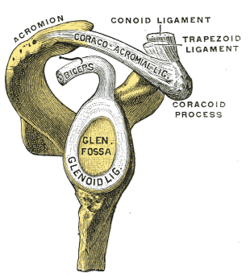Glenoid labrum
| Glenoidal labrum | |
|---|---|
 Lateral view of the shoulder showing the glenoid labrum (marked "glenoid lig.") | |
| Details | |
| Identifiers | |
| Latin | labrum glenoidale |
| TA98 | A03.5.08.002 |
| TA2 | 1765 |
| FMA | 23290 |
| Anatomical terminology | |
The glenoid labrum (glenoid ligament) is a fibrocartilaginous (but not
glenoid fossa of the scapula) is quite shallow and small, covering at most only a third of the 'ball' (the head of the humerus). The socket is deepened by the glenoid labrum, stabilizing the shoulder joint.[1][2]
The labrum is triangular in section; the base is fixed to the circumference of the cavity, while the free edge is thin and sharp.
It is continuous above with the tendon of the long head of the
biceps brachii, which gives off two fascicles
to blend with the fibrous tissue of the labrum.
Structure

Clinical significance
Injury
Tearing of the labrum can occur from either
SLAP lesion (superior labrum, anterior to posterior) is a tear where the glenoid labrum meets the tendon of the long head of the biceps muscle. Symptoms include increased pain with overhead activity, popping or grinding, loss of strength, and trouble localizing a specific point of pain.[3] Because a SLAP lesion involves the biceps, pain and weakness may also be felt when performing elbow flexion
with resistance.
Diagnosis
Computed Tomography) scan to be conducted utilizing contrast injections to highlight where tears may be present. However, due to inherent variability between humans, manual tests, when possible, are more accurate in determining the presence of a labral tear.[4]
Treatment
Detachment of the glenoid labrum often requires surgery to reattach it to the glenoid fossa.[5] Arthroscopic surgical techniques can also be used for more minor detachments.[5]
See also
- Bankart lesion
- Hill-Sachs lesion
References
![]() This article incorporates text in the public domain from page 319 of the 20th edition of Gray's Anatomy (1918)
This article incorporates text in the public domain from page 319 of the 20th edition of Gray's Anatomy (1918)
- ISBN 978-0-323-04177-5, retrieved 25 October 2020
- ISBN 978-0-323-39370-6, retrieved 25 October 2020
- ISBN 978-0-323-39370-6, retrieved 25 October 2020
- PMID 12724682. Retrieved 28 November 2016.
- ^ ISBN 978-1-78242-449-9, retrieved 25 October 2020
External links
Wikimedia Commons has media related to Glenoid labrum.
- upper%20extremity/arthrogramaxial2 at the Dartmouth Medical School's Department of Anatomy
- http://orthoinfo.aaos.org/topic.cfm?topic=a00426
- https://web.archive.org/web/20121119012737/http://www.orthospecmd.com/SLAPlesion.html
- http://www.carlosguanchemd.com/wp-content/uploads/2012/08/Clinical-Testing-for-Tears-of-the-Glenoid-Labrum.pdf
